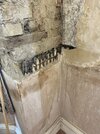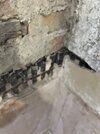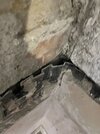I’m renmovating an old house and stumbled across something which has had recent plaster attached to it. I want to strip the wall to add insulation, is this something I should worry about or is it old damp proofing?
You are using an out of date browser. It may not display this or other websites correctly.
You should upgrade or use an alternative browser.
You should upgrade or use an alternative browser.
Is this a damp proofing?
- Thread starter tonDIy
- Start date
Thanks, the material is malleable though and breaks off when bent to much. I think the metal band is just keeping its shape, if it’s not metal then would it still need to be left in situ? It’s a really cold room and I want to insulate&board
It looks to me like plastic lathing used as a damp barrier in cellars. It is shaped so that render or plaster will key into the dovetailing grooves.
There seems to be a new cement render beneath which would fit this diagnosis.
Do not drill or damage it.
You need to avoid letting new plaster bridge to the damp wall.
Where is ground level?
There seems to be a new cement render beneath which would fit this diagnosis.
Do not drill or damage it.
You need to avoid letting new plaster bridge to the damp wall.
Where is ground level?
Thanks John, this is the ground floor which is a little strange, why would they use this instead of a damp vapour membrane? The wall paper was at least 10 years old. If I was to remove it and add a damp vapour barrier below the insulation would this be sufficient?
Just overboard it, with the right technique you should be able to isolate any damp.Thanks, the material is malleable though and breaks off when bent to much. I think the metal band is just keeping its shape, if it’s not metal then would it still need to be left in situ? It’s a really cold room and I want to insulate&board
Blup
Don't remove it.
I think it is moulded PVC though older ones were fibrous bitumen.
You could usefully find out where the water is coming from.
Common sources are broken drains and leaking pipes, or slopes causing rain to puddle against the house.
Where is ground level?
Photograph the entire outside wall please.
I think it is moulded PVC though older ones were fibrous bitumen.
You could usefully find out where the water is coming from.
Common sources are broken drains and leaking pipes, or slopes causing rain to puddle against the house.
Where is ground level?
Photograph the entire outside wall please.
What’s the benefit of keeping it in this case? We’d like to insulate the whole wall and don’t mind putting up new vapour barrier.
We know where the water is coming from, it’s a broken drain outside. But still it’s an external corner room so we want to insulate the external walls.
We know where the water is coming from, it’s a broken drain outside. But still it’s an external corner room so we want to insulate the external walls.
If you have a broken drain, don't destroy your damp protection until after the fault has been repaired and you have seen evidence that the wall has dried out and does not get damp again.
Insulate the wall and dryline over it.
When the wall is dry, it will not be so cold.
I gather you don't want to say where ground level is, or to show us the outside wall.
Insulate the wall and dryline over it.
When the wall is dry, it will not be so cold.
I gather you don't want to say where ground level is, or to show us the outside wall.
Ive seen a system like that where the outside ground level is higher that floor and not practical or too expensive to lower. It stops water coming into the living space by directing down the vertical channels in to a drain or a sump from where its pumped out so best not to be destroying it without further research




